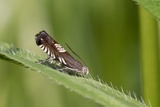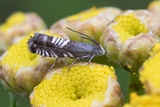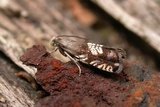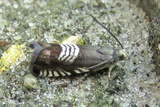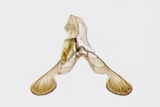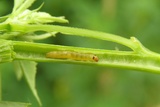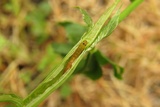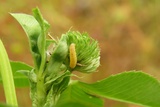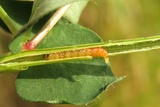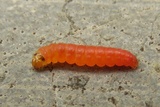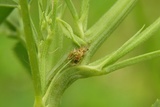Grapholita compositella (Fabricius, 1775) Species
Last modified: Feb. 8, 2024, 4:57 p.m.
A rather common species throughout Belgium.
Details
- Classification
- Family: Tortricidae > Subfamily: Olethreutinae > Tribus: Grapholitini > Genus: Grapholita > Subgenus: Grapholita > Species: Grapholita compositella
- Vernacular names
- Sergeant-majoortje (NL), Triple-stripe Piercer, Meadow Tortrix (EN), Kleewickler (DE)
- Synonyms
- Grapholita composana (Duponchel, 1836)
- First mention in Belgium
- De Sélys-Longchamps E. 1844. Énumération des insectes Lépidoptères de la Belgique. — Mémoires de la Société royale des Sciences de Liége 2: 1–35. On page 21.
- Status
-
Native
Distribution
Imago
Wingspan 8–10 mm. A small Tortricid with dark fuscous or grey forewings and a dorsal blotch divided into 4 long white striaea. There are four pairs of white strigulae on the costa which subtend short metallic violet stria. There is also a leaden metallic ocellus.
Bionomics
The larva lives in the stem which often causes wilting or distorted growth of one or more leaves of the shoot or between spun or folded leaves, flowers or seeds on the host plant. The full-fed larva hibernates. It pupates in a white silken cocoon spun amongst leaf-litter. The larvae of the second generation and those of the univoltine populations hibernate within the cocoon and pupate in spring. The pupa protrudes the cocoon shortly before emergence.
The males are active in afternoon sunshine, the females towards sunset. Later they come occasionally to light.
Flight periods
The adults have been seen from mid-April towards mid-September in two generations a year. Biggest numbers during May and July.
Observed on
- Host plant (species):
- Trifolium pratense, Trifolium repens and Lotus corniculatus
- Host plant (genera):
- Trifolium
The larva lives various species of Fabaceae, mainly on Trifolium pratense, Trifolium repens, Trifolium hybridum, Melilotus albus, Medicago sativa, Astragalus cicer, and Lotus corniculatus.
Habitat
It inhabits dry grassland, clover fields and flowery meadows.
